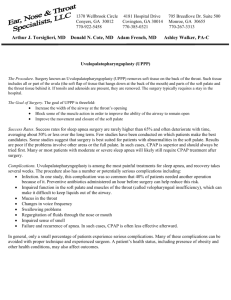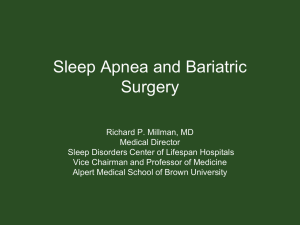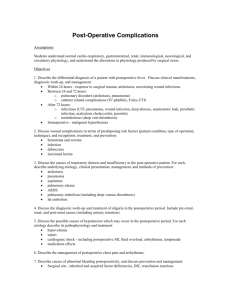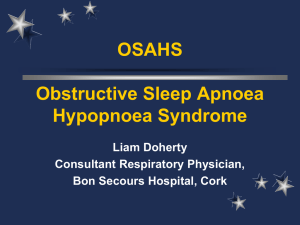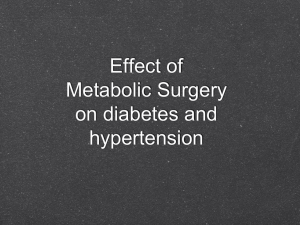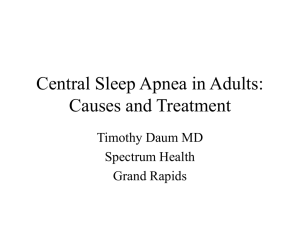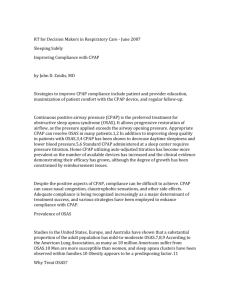Apresentação do PowerPoint
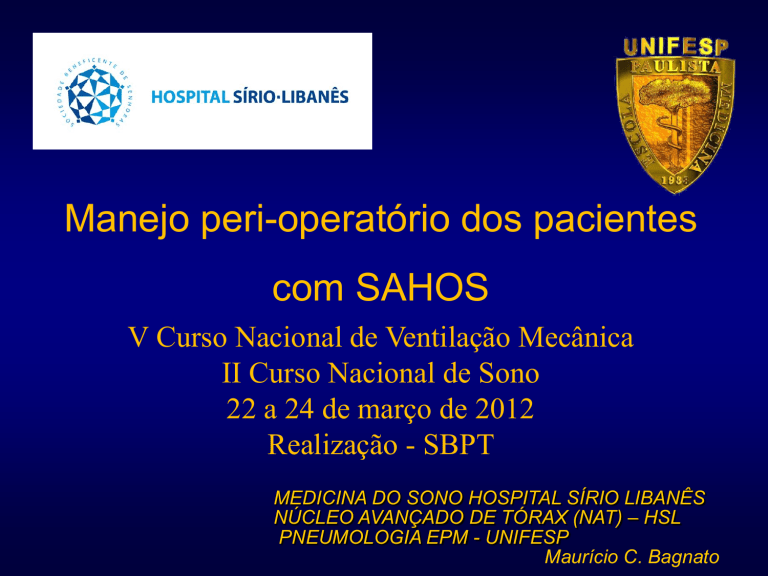
Manejo perioperatório dos pacientes com SAHOS
V Curso Nacional de Ventilação Mecânica
II Curso Nacional de Sono
22 a 24 de março de 2012
Realização - SBPT
MEDICINA DO SONO HOSPITAL SÍRIO LIBANÊS
NÚCLEO AVANÇADO DE TÓRAX (NAT) – HSL
PNEUMOLOGIA EPM - UNIFESP
Maurício C. Bagnato
Síndrome da Hipoventilação-Obesidade - SHO
Síndrome da Hipoventilação-Obesidade - SHO
Piper 0 A. J. Sleep Med Rews 2010
Síndrome da Hipoventilação-Obesidade - SHO
Upper Airway Management of the Adult Patient with
Obstructive Sleep Apnea in the Perioperative Period -
Avoiding Complications .
Clinical Practice Review Committee - American Academy of Sleep Medicine
SLEEP 2003;26(8):1060-5.
Fatores que contribuem para o risco peri-operatório
• ↑ Instabilidade de VVAASS devido a anestésicos e analgésicos narcóticos
• Efeitos cardiopulmonares devido a SAHOS
• ↓ Capacidade residual funcional e reserva oxigenação no obeso
• ↓ do “drive” ventilatório devido a agentes anestésicos
Upper Airway Management of the Adult Patient with Obstructive Sleep Apnea in the
Perioperative Period - Avoiding Complications .
Clinical Practice Review Committee - American Academy of Sleep Medicine
SLEEP 2003;26(8):1060-5.
SAHOS (PSG no prontuário / CPAP ideal / doença residual (↑peso) / CPAP pré e POI
S/ diag SAHOS (Hist / EF / menop / acompanhante / questionário / obeso ou não / CPAP empírico no POI se urgência – aceitação?, auto-CPAP? )
Entubação preparo (drogas anti-refluxo e antisilogogas? / pré-oxigenação / masc laríngea?
Entubação (s/n fibr óptica / se insucesso – masc, obturador esof,, jet vent transtr s/n traqueo)
Anestésico (c/ ou s/ sedação? – melhor sem – geral / se possível bloq regional / epidural?
Extubação (perder control VVAA / edema pulmonar / tônus musc adeq / dec elevado apenas? – CPAP
POI (primeiras 24hs críticas – UTI / rebote REM / analgesia cautelosa / sinergismo / comorbidades / PCA c/ limite / Oximetria e Fc c/ alarmes / CPAP adequado se rc ↑ pressão
Obstructive Sleep-Related Breathing Disorders in
Patients Evaluated for Bariatric Surgery
Obesity Surgery, 13, 2003
Summary
The incidence of OSRBD in our bariatric study population was very high. Cardiovascular consequences of OSRBD are well documented. These consequences may be increased in the postoperative period when the combination of REM rebound and narcotic analgesia increase oxyhemoglobin desaturations.
Health-care providers evaluating patients for bariatric surgery should consider referral for a sleep
Obstructive Sleep-Related Breathing Disorders in
Patients Evaluated for
Bariatric Surgery
Obesity Surgery, 13, 2003
Evaluation and PSG as part of the preoperative evaluation.Clinical evaluation with BMI, Epworth Sleepiness Scale and the
Mallampati airway classificationfailed to predict the severity of
OSRBD. Therapy for OSRBD should be initiated prior to surgeryto minimize the hemodynamic complications of OSRBD and to familiarize the patient with CPAP. Patients should be educated about the importance of CPAP use to correct OSRBD.
Continued use of CPAP in the postoperative period will theoretically decrease the potential morbidity and mortality of
OSRBD in the hospital and after discharge from the hospital.
Evidence Supporting Routine
Polysomnography
Before Bariatric Surgery
Obesity Surgery, 14, 23-26, 2004
Conclusions: In this large patient cohort, sleep apnea was prevalent (77%) independent of BMI, and most cases were not diagnosed before bariatric surgical consultation. These data support the use of routine screening polysomnography before bariatric surgery.
Postoperative Complications in Patients With
Obstructive Sleep Apnea Syndrome Undergoing
Hip or Knee Replacement: A Case-Control Study
Mayo Foundation for Medical Education and Research Volume
76(9), September 2001, pp 897-905
CONCLUSIONS
In this study, we have shown that the presence of OSAS in patients undergoing elective hip replacement or knee replacement is associated with a considerable number of complications in the postoperative period. Almost one third of the patients with OSAS in our study suffered a substantial respiratory or cardiac complication. Patients who were not using CPAP prior to hospitalization had a significantly higher incidence of serious complications. Patients diagnosed with
OSAS have been shown to be heavy consumers of health care resources for several years prior to diagnosis and the utilization decreases after starting treatment in patients who adhere to the treatment.
Postoperative Hypoxemia in Morbidly Obese Patients
With and Without Obstructive Sleep Apnea Undergoing
Laparoscopic Bariatric Surgery
(Anesth Analg 2008;107:138 –43)
CONCLUSIONS: In morbidly obese subjects, in the first 24 h after laparoscopic bariatric surgery, OSA does not seem to increase the risk of postoperative hypoxemia. Our data confirm that morbidly obese subjects, with or without OSA, experience frequent oxygen desaturation episodes postoperatively, despite supplemental oxygen therapy suggesting that perioperative management strategies in morbidly obese patients undergoing laparoscopic bariatric surgery should include measures to prevent postoperative hypoxemia.
Identification of patients at risk for postoperative respiratory complications using a preoperative obstructive sleep apnea screening tool and postanesthesia care assessment .
Department of Anesthesiology, Mayo Clinic, Rochester, Minnesota
55905, USA. gali.bhargavi@mayo.edu
Anestthesiology 2009 Apr;110(4):869-77.
CONCLUSIONS:
Combination of an obstructive sleep apnea screening tool preoperatively (SACS) and recurrent PACU respiratory events was associated with a higher oxygen desaturation index and postoperative respiratory complications. A two-phase process to identify patients at higher risk for perioperative respiratory desaturations and complications may be useful to stratify and manage surgical patients postoperatively .
